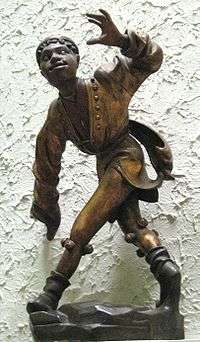Erasmus Grasser

Erasmus Grasser (c. 1450 – c. 1515) was a leading master builder and sculptor[1] in Munich in the early 16th century.
Biography
He developed in an animated and realistic style, furthering on the works of Nikolaus Gerhaert.
Grasser worked mainly in wood, and is best known for the 16 figures of Moriskentänzer (Moresca dancers, 1480, 10 remaining, the fate of 6 unknown) lining the walls of the great dance and assembly hall of Old Townhall, the oak choir stalls at the Frauenkirche cathedral (1502) and the madonna of the high altar in St Mary (Ramersdorf), all three located in Munich. He also created the high altar at Reichersdorf (1502–1506).
Works
Grasser is credited with creating the 'Burial of the Virgin' though it may have been a follower of his. This piece depicts Mary, the Mother of God, in a coffin being carried to her final resting place. This story is not mentioned in the Bible. In an apocryphal collection of stories called Transitus Mariae attributed to Bishop St. Melito of Sardis, Mary died in the presence of the Apostles and one version of what happened to her body is that the Apostles then buried her.[2]
References
- Philipp M. Halm, Erasmus Grasser, 1927
- ↑ Emmerson,R."Key Figures in Medieval Europe: An Encyclopedia"-pg 268
- ↑ Saunders, Father William. The Dormition of Mary
External links
| Wikimedia Commons has media related to Erasmus Grasser. |
- Moresca Dancers at the Munich Museum.
- Burial of the Virgin at the Legion of Honor in San Francisco